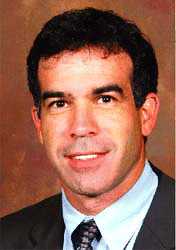Physicians can successfully perform ultrasound-guided (US) fine-needle aspiration biopsy (FNAB) of thyroid nodules in the office instead of referring patients to a hospital-based radiologist for the procedure, according to new data presented at the annual meeting of the American Academy of Otolaryngology-Head and Neck Surgery. It’s not all about the palate, according to Michael Freidman, MD, Professor of Otolaryngology at Rush University Medical Center in Chicago, who is known for developing the Friedman Tongue Position classification system.
Explore This Issue
February 2008We were able to get adequate biopsy results 93% of the time without the patient having to go to a hospital-based institution, said the study’s lead author, David L. Steward, MD, Director of the Thyroid and Parathyroid Program and Associate Professor in the Department of Otolaryngology/Head and Neck Surgery at the University of Cincinnati.
Having an otolaryngologist-head and neck surgeon perform FNAB in the office saves the patient time, explained Dr. Steward. Traditionally, office-based physicians refer patients to a hospital to see a radiologist for FNAB. Another advantage of performing office-based ultrasound (US) and ultrasound-guided fine-needle aspiration (US-FNAB) is that the performing physician is familiar with the patient’s history and symptoms, he said.
Head and neck surgeons are increasingly acquiring US as part of comprehensive diagnosis and management of their patients, noted David J. Terris, MD, Porubsky Professor and Surgical Director of the Medical College of Georgia Thyroid Center in Augusta. A natural extension of this is to use the technology to perform fine-needle aspiration biopsies, he said.
The Data
Dr. Steward and his colleagues evaluated data from a prospective cohort study of 447 consecutive office-based US-FNAB procedures conducted in his practice between 2003 and 2006. On-site cytopathologic evaluation of the specimen adequacy was not available.
Three to four needle passes under real-time US on target nodules were used. The first pass consisted of capillary sampling, and specimens were placed on glass. Other passes used aspiration, and specimens were placed in a methanol-based, buffered transport solution.
An adequate specimen was defined as having five to six clusters of thyroid follicular cells. If the specimen contained no follicular cells, the researchers considered it nondiagnositic. If it contained insufficient follicular cells, it was suboptimal.
Overall, researchers were able to obtain adequate specimens in 92.6% of the 447 cases. Nondiagnostic specimens occurred in 3.6% of the 447 cases, and suboptimal specimens occurred in 3.8%.
Cytologists found that 4.5% of specimens were malignant. Atypical or suspicious features were found in 8.3% of specimens. A benign cytological diagnosis was made in 79.9% of 447 specimens, of which 1.1% were false-negative.
The Procedure
In the office-based setting, the need for the procedure generally arises when a patient comes in for a consultation with a surgeon, said Dr. Steward. The physician performs an initial diagnostic US and a US-guided FNAB using local anesthetic, and then sends specimens to a cytopathology lab, he said.

Leave a Reply